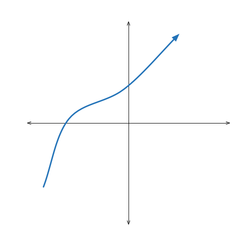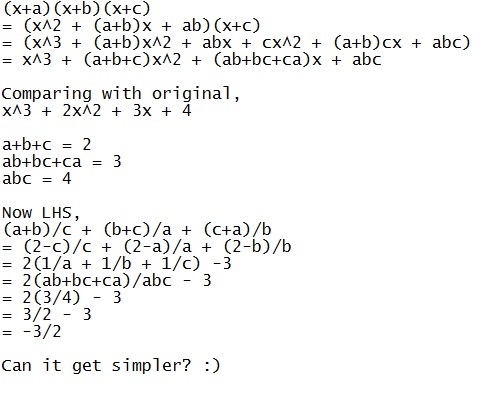Polynomial Vieta
 The roots of the polynomial equation
x
3
+
2
x
2
+
3
x
+
4
=
0
are
α
,
β
,
and
γ
. What is the value of
The roots of the polynomial equation
x
3
+
2
x
2
+
3
x
+
4
=
0
are
α
,
β
,
and
γ
. What is the value of
γ α + β + α β + γ + β γ + α ?
This section requires Javascript.
You are seeing this because something didn't load right. We suggest you, (a) try
refreshing the page, (b) enabling javascript if it is disabled on your browser and,
finally, (c)
loading the
non-javascript version of this page
. We're sorry about the hassle.
9 solutions
Sum of reciprocals of roots = - 3/4 directly from Vieta's Theorem !!
This solution is so clear that without having known Vieta's Theorem before, I now seem to understand it, including the sum of reciprocal of roots. Great solution!
Hmm. I did it a slightly different way, also with Vieta's:
We have {█(α+β+γ=-2, αβ+βγ+γα=3, αβγ=-4)┤ so then -6=(-2)(3)=(α+β+γ)(αβ+βγ+γα)=α^2 β+αβ^2+β^2 γ+βγ^2+γ^2 α+γα^2+3αβγ and so α^2 β+αβ^2+β^2 γ+βγ^2+γ^2 α+γα^2=-6-3αβγ=6 and so (α+β)/γ+(β+γ)/α+(γ+α)/β=(α^2 β+αβ^2+β^2 γ+βγ^2+γ^2 α+γα^2)/αβγ=6/(-4)=-3/2.
Nice solution; I had to newton sum bash it.
Easy solution....but i couldnt :(
I'm new to this but isn't it possible to reduce the polynomials and particles equation then simplifying it to find the unknown variables tried and it works but maybe I just got lucky
Log in to reply
3 equations 3 unknowns it's possible to find the roots and plug them into the equation. Given the symmetrical statement, we usually can find a more elegant solution.
i forgot how to figure out the solution of polynomial equations also this theorem is new to me .. but it worked .. thanks :)
I think something same to u but couldn't done,but impressed about u
good solving
Subtracting and adding 3 to both sides of the given expression yields:
γ α + β + γ + α α + β + γ + β α + β + γ − 3
= ( α + β + γ ) ( γ 1 + α 1 + β 1 ) − 3
= ( α + β + γ ) ( β γ α α β + β γ + γ α ) − 3
We can easily calculate the values of these cyclic sums using Vieta's formula from the given polynomials, substitute the values, and get the desired answer.
@Krishna Ar : Sorry, I meant symmetric sums of roots.
A small note- Vieta's formulae do not calculate cyclic sums.
Good question....and solution.
Prepare the equations we need first so that it will be easier later when we try to solve it.
By Vieta's Formula,
α + β + γ = − 2
α β + β γ + γ α = 3
( α β γ ) = − 4
Now that we've prepared everything necessary, we start by turning the problem given into a single fraction and see what we can do next
γ α + β + α β + γ + β γ + α
= α β γ α β ( α + β ) + β γ ( β + γ ) + γ α ( α + γ )
We still can't do anything with this, we need to turn this fraction into something we can solve with the equations prepared earlier.
So, we can let α + β become α + β + γ − γ and the same thing with the other ones.
α β γ α β ( α + β + γ − γ ) + β γ ( α + β + γ − α ) + γ α ( α + β + γ − β )
Now we can almost solve it by replacing α + β + γ with − 2 , but there are still some that we can't substitute a value into it.
We can multiply out the extra negative value from the bracket.
α β γ α β ( α + β + γ ) + β γ ( α + β + γ ) + γ α ( α + β + γ ) − 3 ( α β γ )
Then,
α β γ ( α β + β γ + γ α ) ( α + β + γ ) + ( α + β + γ ) + ( α + β + γ ) − 3 ( α β γ )
Finally, substitute in the values we'd precomputed
− 4 3 ( − 2 ) − 3 ( − 4 )
= − 4 6
= − 2 3
nice.........
Sum of all roots = -2; sum of two roots at a time = 3; product of roots = -4
Combining the expression, you get ((a + b + c)(ab + bc + ac) - 3abc)/abc = -3/2
We see that ( a + b + c ) ( a b + b c + c a ) = 3 a b c + ∑ a 2 b and the fraction we want is a b c ∑ a 2 b . Hence, we plug in and finish with Vieta.
from given polynomial equation........ α+β+ϒ=-2 αβ + βϒ+ βϒ=3 αβϒ=-4 now, (α+β)/ϒ+(β+ϒ)/α+(ϒ+α)/β
=> (-2-ϒ)/ϒ + (-2-α)/α + (-2-β)/β
=> ((-2)/ϒ + (-2)/α + (-2)/β) - 3
=> ((-2(αβ + βϒ+ βϒ))/αβϒ) - 3 => ((-2×3)/(-4))-3= - 3/2
a + b + c = -2.....(a + b)/c = ( -2 - c )/c = -2/c - 1...(b+c)/a = - 2/a -1...(c+a)/b = -2/b - 1
Exp. = -2/c -1 - 2/b - 1 - 2/a -1 = -2{ 1/c +1/b + 1/a} - 3
Sum of reciprocals = - 3/4...
Exp. - 2 * (- 3/4 ) -3 = - 3/2
Didn't anybody just solve for alpha, beta, and gamma?
Log in to reply
The only way to solve it would be using the cubic formula, because there are no rational roots. For that matter, there are only one real and two complex roots.

By Vieta's Formula ,
α + β + γ = − 1 2 = − 2
α β + α γ + β γ = 1 3 = 3
α β γ = − 1 4 = − 4
Hence,
γ α + β + α β + γ + β γ + α
= γ − 2 − γ + α − 2 − α + β − 2 − β
= − γ 2 − 1 − α 2 − 1 − β 2 − 1
= − ( α 2 + β 2 + γ 2 ) − 3
= − ( α β γ 2 β γ + 2 α γ + 2 α β ) − 3
= − ( − 4 2 ( α β + α γ + β γ ) ) − 3
= 4 2 ( 3 ) − 3 = − 2 3